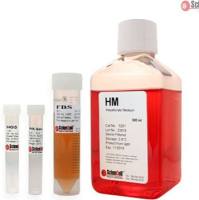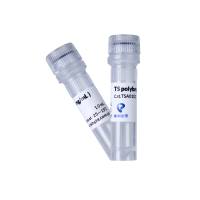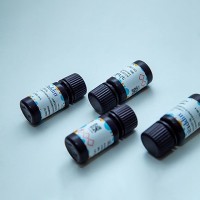|
ABSTRACT |
Efficient transfer and sustained expression of transgenes are among the most important issues in gene delivery technologies. The majority of hematopoietic cells, including hematopoietic stem/progenitor cells and terminally differentiated cells, such as primary T cells and macro phages, are nondividing or slowly self-renewing. These cell types are refractory to most nonviral or retroviral delivery methods. Lentiviral vectors are capable of transducing nondividing cells and maintaining long-term and sustained expression of the transgenes. Many hematopoietic cell types have been successfully transduced with lentiviral vectors carrying a variety of genes. Lentiviral vectors are becoming useful for many delivery protocols, such as long-term expression of short hairpin RNA (shRNA) and functional genetics. They may also have great potential in gene therapy.
This protocol describes lentivirus-vector-based delivery of foreign genes to hematopoietic cells. The method is applicable to various cell types in experiments that require long-term transgene expression. |
|
|
|
MATERIALS |
|
Reagents |
-
-
Anti-CD34 antibody-coupled magnetic beads (if transducing primary hematopoietic stem cells)
-
-
Bovine serum albumin (BSA; 2% in PBS)
-
-
Dissolve 2 g of BSA (Fraction V) in 100 ml of PBS. Sterilize by passage through a 0.2- µm filter. Store at 4°C.
-
-
-
CaCl2 (2 M)
-
-
Dissolve 29.4 g of CaCl2 in 70 ml of H2 O. Adjust the volume to 100 ml.
-
-
Sterilize by passage through a 0.2-µm filter.
-
-
-
Cells
-
-
293T (human embryonic kidney cells containing SV40 large T antigen)
-
-
HT1080 (a human fibrosarcoma cell line)
-
-
Cells to be transduced (target cells)
-
-
-
Formaldehyde (3.7% in PBS)
-
-
Prepare a 1:10 dilution of 37% formaldehyde solution with PBS.
-
-
-
2x HEPES-buffered saline (HBS; 0.05 M HEPES, 0.28 M NaCl, and 1.5 mM Na2 HPO4 at pH 7.12)
-
-
Dissolve 2.38 g of HEPES, 3.28 g of NaCl, and 42.6 mg of Na2 HPO4 in 200 ml of H2 O. Sterilize by passage through a 0.2-µm filter.
-
-
-
Medium for 293T cells and HT1080 cells
-
-
Use Dulbecco's modified Eagle's medium (DMEM) with high glucose (4500 mg/liter) supplemented with 10% fetal bovine serum (FBS), 100 units/ml penicillin, and 100 µg/ml streptomycin
-
-
-
Medium for target cells
-
-
Choose appropriate media, cytokines, and other supplements depending on cell types and the experimental design. For the example in this protocol, use CD34+ transduction medium: Iscove's modified Dulbecco's medium (IMDM) supplemented with 20% BIT9500, 100 ng/ml of stem cell factor (SCF), 100 ng/ml of Flt3-ligand, and 10 ng/ml of thrombopoietin (TPO).
-
-
-
Phosphate-buffered saline (PBS, pH 7.4)
-
-
137 mM NaCl
-
-
2.7 mM KCl
-
-
8.1 mM Na2 HPO4
-
-
1.5 mM K2 H2 PO4
-
-
-
Plasmid DNA
-
-
The plasmid DNAs in this protocol include pHIV7-GFP containing the desired transgenes, pCgp, pCMV-rev, and pCMV-G.
-
-
-
Polybrene (4 mg/ml)
-
-
Dissolve 40 mg of polybrene (hexadimethrine bromide) in 10 ml of H2 O. Sterilize by passage through a 0.2-µm filter. Store at 4°C.
-
-
-
RetroNectin
-
-
Prepare 25 µg/ml RetroNectin solution according to the manufacturer's instructions. Store at 4°C.
-
-
-
Sodium butyrate (0.6 M)
-
-
Dissolve 3.3 g of sodium butyrate in 50 ml of H2 O. Sterilize by passage through a 0.2-µm filter. Store at 4°C.
-
-
-
TE 79/10
-
-
Prepare a 1:10 dilution of TE79 (10 mM Tris-HCl and 1 mM EDTA at pH 7.9) with H2 O. Sterilize by passage through a 0.2-µm filter.
-
-
|
|
Equipment |
-
-
Centrifuge tubes (1 x 3.5-inch polyallomer)
-
-
Autoclave (15 psi, 15-20 min) before use.
-
-
-
Fluorescence-activated cell sorter (FACS)
-
-
Incubator (37°C)
-
-
Nontissue-culture-treated plates (48 and 24 well)
-
-
Plate (12 well)
-
-
Syringe (30 ml)
-
-
Syringe filter (0.2 m)
-
-
Tissue culture dishes (100 mm)
-
-
Ultracentrifuge and SW 28 rotor
-
|
METHOD
|
-
Production of Lentiviral Vectors: Packaging of the Vectors
-
-
-
Maintain 293T cells in complete culture medium in a 37°C incubator with 5% CO2. Twenty-four hours before transfection, plate exponentially growing 293T cells in 100-mm tissue culture dishes at 4 x 106 cells/plate.
Cell density should be approximately 80% confluent for transfection.
-
-
Prepare 1 ml of calcium phosphate-DNA suspension for each 100-mm plate of cells as follows:
-
-
Set up two sterile tubes for transfection of one plate. Label the tubes 1 and 2.
-
-
Add 0.5 ml of 2x HBS to Tube 1.
-
-
Add TE 79/10 to Tube 2. The volume of TE 79/10 = 440 µl minus the volume of the DNA solution.
-
-
Add 15 µg of the transfer vector containing the transgene, 15 µg of pCgp, 5 µg of pCMV-rev, and 5 µg of pCMV-G to Tube 2 and mix.
-
-
Add 60 µl of 2 M CaCl2 solution to Tube 2 and mix gently.
-
-
Transfer the contents from Tube 2 to Tube 1 dropwise with gentle mixing.
-
-
Allow the suspension to sit for 30 minutes at room temperature.
-
-
-
Mix the precipitate well by pipetting or vortexing
-
-
Add 1 ml of the suspension to a 100-mm plate containing cells. Add the suspension slowly, dropwise while gently swirling the medium in the plate. Return the plates to the 37°C incubator and leave the precipitate for 4 hours.
-
-
Replace the old medium with 6 ml of fresh culture medium. Add 60 µl of 0.6 M sodium butyrate. Return to the incubator.
-
-
After 48 hours of culture, collect the supernatant and freeze it at -80°C or proceed to the concentration step.
Concentration of the Vectors
-
-
Centrifuge the supernatant (freshly collected or thawed from the freezer) at 900g for 10 minutes to remove any cell debris in the supernatant.
-
-
Filter the supernatant through a 0.2-µm syringe filter.
-
-
Transfer the supernatant to autoclaved polyallomer tubes. Concentrate the supernatant by ultracentrifugation for 1.5 hours at 4°C in a Beckman SW 28 swinging bucket rotor at 24,500 rpm.
-
-
Remove the supernatant and resuspend the pellet in an appropriate amount of culture medium, e.g., 300 µl for 30 ml of original supernatant if a 100-fold concentration is desired.
-
-
Divide the concentrated vector into 10-50-µl aliquots and store at -80°C until use.
Titration of the Vectors
-
-
Seed 5 x 104 HT1080 cells/well in a 12-well plate in complete medium and culture overnight in a 37°C incubator with 5% CO2 .
-
-
Add serial diluted vector stock and 4 µl/ml polybrene to the cultured cells. Continue culture for 48 hours.
-
-
Trypsinize the cells. Following centrifugation, remove the supernatant and resuspend the pellet in 300 µl of 3.7% formaldehyde in PBS.
-
-
Determine the percentage of EGFP-positive cells by FACS analysis.
The titer will be represented as transduction units (TUs) per milliliter concentrated vector (TU/ml).
<center>
</center>
Transduction of Lentiviral Vectors to Target Cells
For transducing cultured hematopoietic cells
-
-
Seed exponentially growing cells at 2 x 105 cells/well in 1 ml of culture medium into a 24-well plate.
-
-
Add various amounts of concentrated vector stock depending on cell type. For the K562 cell line (CML leukemia cell line), a multiplicity of infection (moi) of 10 can achieve virtually 100% transduction.
-
-
Add 4 µg/ml polybrene. Return the cells to a 37°C incubator.
-
-
After overnight incubation, centrifuge the cells, discard the supernatant, and resuspend the cells with fresh culture medium. Return the cells to culture.
-
-
Determine transduction efficiency by FACS analysis 48 hours after transduction (see Troubleshooting).
For transducing primary hematopoietic stem cells
-
-
Purify CD34+ hematopoietic stem cells from umbilical cord blood or bone marrow using anti-CD34 antibody-coupled magnetic beads following the manufacturer's protocol.
-
-
Forty-eight hours before transduction, culture the CD34+ cells in CD34+ transduction medium.
-
-
Coat a 48-well nontissue-culture-treated plate with 0.2 ml of 25 µg/ml RetroNectin (~5 µg/cm2) for 2 hours at room temperature
-
-
Remove RetroNectin and then add 0.2 ml of 2% BSA in PBS for blocking. Store the plate for 30 minutes at room temperature.
-
-
After washing the wells with PBS, adjust the lentiviral vector stock to the appropriate moi (range 5-40) with plain IMDM medium to 200-µl volume and load it into the well of the coated plate.
-
-
After incubation for 2 hours at 37°C, remove the vector supernatant and then wash the well with PBS.
-
-
Add the prestimulated CD34+ cells to the well at 1 x 105 cells/well in 0.2 ml of growth medium and return the cells to the 37°C incubator.
-
-
After overnight culture, centrifuge the cells, resuspend the cell pellet in 1 ml of culture medium, and transfer the cells to a 24-well plate. Return the cells to the incubator.
-
-
Determine transduction efficiency by FACS analysis 6 days after transduction.
-
|
TROUBLESHOOTING
|
Problem (Step 20): Some cell types, such as CEM (a human T cell line), are difficult to transduce by the standard protocol.
Solution: For those cell types that resist transduction by normal means, centrifugation can substantially enhance the transduction efficiency. Treat these cells as follows. Combine 2 x 105 cells in 1 ml of culture medium in a 15-ml centrifuge tube with vector and 4 µg/ml polybrene. Centrifuge at 900g for 30 minutes at 20°C. Then, without removing the supernatant, use a pipette to resuspend the cell pellet and transfer the cells to the culture plate. Incubate the cells overnight, replace the medium, and continue the culture. |
|
ACKNOWLEDGMENTS |
|
We thank Dr. Jiing-Kaun Yee for providing pHIV7-GFP and the packaging plasmids. The authors were supported by National Institutes of Health grants AI29329, AI42552, and HL074704. |
|
|
Anyone using the procedures in this protocol does so at their own risk. Cold Spring Harbor Laboratory makes no representations or warranties with respect to the material set forth in this protocol and has no liability in connection with the use of these materials. Materials used in this protocol may be considered hazardous and should be used with caution. For a full listing of cautions regarding these material, please consult:
Gene Transfer: Delivery and Expression of DNA and RNA, A Laboratory Manual , edited by Theodore Friedmann and John Rossi, © 2006 by Cold Spring Harbor Laboratory Press, Cold Spring Harbor, New York, p. 75-82. |
|
|
|
Copyright © 2006 by Cold Spring Harbor Laboratory Press. All rights reserved. No part of these pages, either text or image may be used for any purpose other than personal use. Therefore, reproduction modification, storage in a retrieval system or retransmission, in any form or by any means, electronic, mechanical, or otherwise, for reasons other than personal use, is strictly prohibited without prior written permission. |







